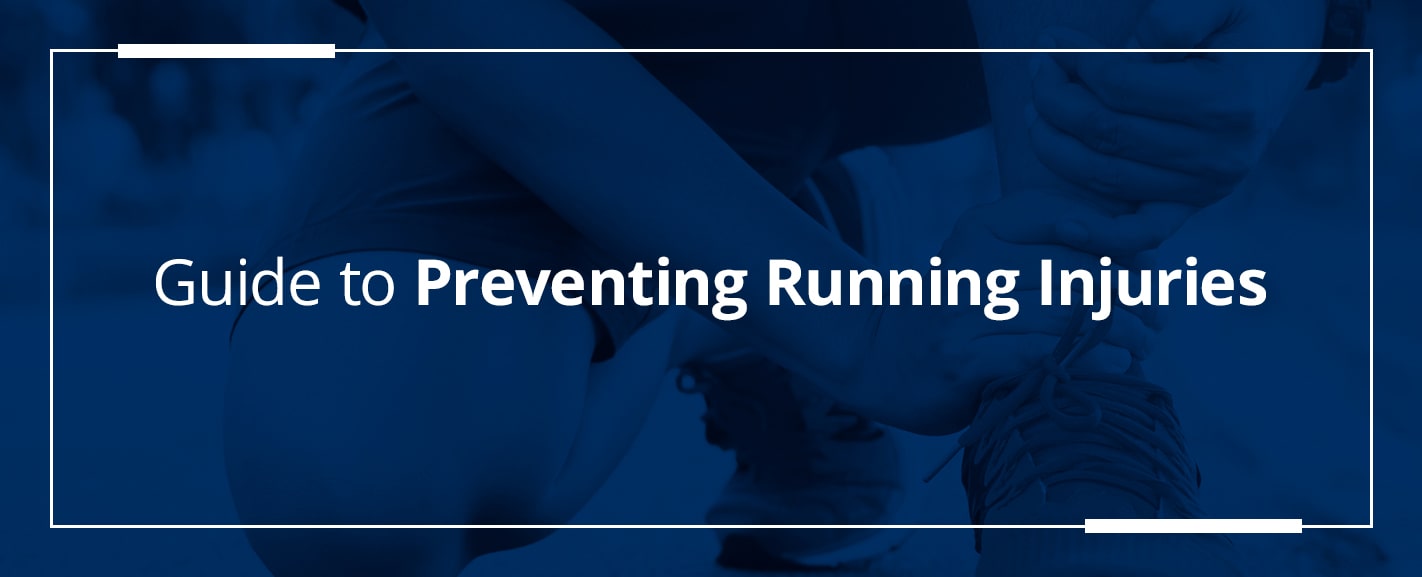
There are approximately 47 million runners and joggers in the U.S., and more than half of those people run at least once a week. Whether you run competitively or just to stay fit, no one wants to experience a running-related injury.
Maybe you find yourself stuck indoors wondering, “Why do I keep getting injured running?” Or maybe you’ve just gotten into running and you want to know how to prevent running injuries before they strike. Perhaps you’re a runner who is ready to start running more frequently, and you’re asking, “How can I run every day and not get injured?” Whatever the case, we’ve created this runner’s guide to injury prevention to help you enjoy this activity pain-free.
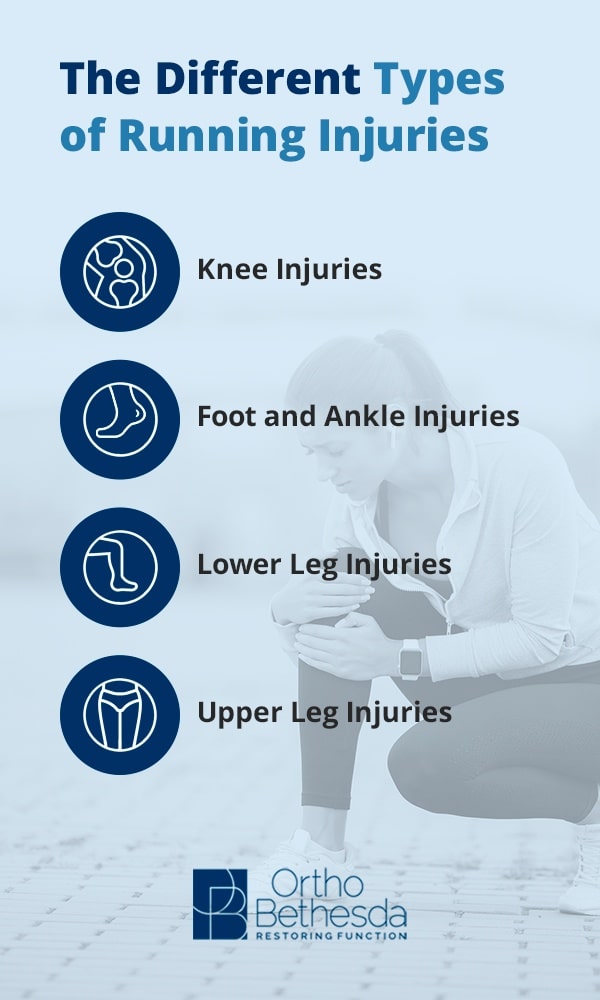
The Different Types of Running Injuries
First, it’s helpful to understand two basic types of injuries: overuse injuries and acute injuries. Running overuse injuries — also called chronic injuries, repetitive stress injuries, repetitive motion injuries or repetitive strain injuries (RSIs) — make up about 80% of running injuries. These injuries, such as runner’s knee, develop over time. Far less common but still problematic are sudden injuries like an ankle sprain or a torn muscle. Beyond these distinctions, we can look at running injuries by the part of the body they affect. Let’s look at some common problem areas for runners.
1. Knee Injuries
When it comes to running injuries, knee pain is one of the most frequent problems runners experience. This pain can be caused by a few different types of knee injuries, including:
- Patellar tendinopathy: The patellar tendon connects the kneecap to the shin bone and helps you extend your knee. Pain or dysfunction in this tendon is known as patellar tendinopathy. The condition is nicknamed jumper’s knee, but it’s a common issue for runners and presents itself as pain in the front of the knee.
- Iliotibial band syndrome: The iliotibial (IT) band is a stretch of connective tissue that spans from the knee to the outer hip and helps to stabilize the knee. When running, this band can frequently rub against your leg bone, leading to an RSI. If you experience sharp pain just above your knee, toward the outer side of your leg, you may be suffering from IT band syndrome.
- Patellofemoral pain syndrome: This problem is more commonly referred to as runner’s knee because it is a common running ailment. The condition involves dull, aching pain around or behind the kneecap due to overuse. In most cases, the pain is worst where the kneecap meets the lower part of the thighbone or femur.
- Meniscal tear: If your knee twists suddenly while you’re putting weight on it, you could experience a tear in your knee’s cartilage between your shinbone and thighbone. This pain may feel like your joint is locking.
2. Foot and Ankle Injuries
Your feet and ankles can also be prone to injury when running. Some possible sources of foot and ankle pain include:
- Ankle sprain: Ankle sprains occur suddenly when your ligaments between the leg and ankle are overstretched. A common scenario is when your weight lands on the outer part of the foot, causing your ankle to roll. Sprains can cause pain, swelling and bruising and make it difficult to put weight on your foot.
- Plantar fasciitis: Fascia is a thick layer of tissue on the bottom of your feet. When you’re running, this tissue provides some spring. If you increase the amount you’re running suddenly, the fascia can experience an excessive amount of stress and become irritated. This condition is known as plantar fasciitis and manifests itself as pain in the bottom of the foot, especially in the area from the heel into the arch.
- Stress fracture: Running injuries of the foot or ankle may also involve a stress fracture — that is, tiny cracks that form in bones due to repetitive stress. You can also experience stress fractures in leg bones.
3. Lower Leg Injuries
The lower leg is another area where running injuries are common. Some problems to watch out for include:
- Tibial stress syndrome: More commonly called shin splints, tibial stress syndrome affects the area along the shinbone in the front and inner parts of the lower legs. Running on hard surfaces or suddenly increasing the amount you run can lead to shin splints. This condition can cause pain, tenderness and swelling, and it can be a forerunner to a stress fracture.
- Calf strains or tears: The calf includes two muscles: the gastrocnemius and the soleus. Since your calf contracts rapidly while you run, running injuries of the calf are fairly common. This could be a pull or tear of either of the calf muscles.
- Anterior compartment syndrome: The tibialis anterior muscle on the outside of the shin can be susceptible to a compartment syndrome. This means that the muscle swells, causing excessive pressure to build in an enclosed muscle space. This is a painful problem that requires medical attention.
- Achilles tendinitis: The achilles tendon is a strong band of tissue connecting calf muscles to your heel bone. Running can cause inflammation in this tendon, a condition known as achilles tendonitis. Your achilles tendon may be inflamed if you feel a dull pain in the back of your lower leg. You may also experience swelling and warmth in that area. Achilles tendinitis puts you at greater risk of rupturing your achilles tendon.
4. Upper Leg Injuries
Running injuries in the hip and upper leg are less common than injuries from the knee down. However, runners are still at risk of experiencing these problems:
- Hamstring strains or tears: The hamstring is a collection of three muscles on the back of the thigh. Any one of these muscles can be strained or even torn when you’re running, causing pain that ranges from mild to intense depending on the severity of the injury.
- Quadricep strains: Another muscle you can pull is the quadricep in the front of the thigh. As with other muscle strains, you can experience pain, tenderness, swelling and bruising.
- Hip flexor strain: The hip flexors are a system of muscles around the hips that allow you to bend your torso and lift your legs toward your torso. A fall or another sudden movement can cause you to strain your hip flexors or even tear a muscle. You can also strain these muscles from overuse. Either way, you can experience pelvic or hip pain from a hip flexor strain.
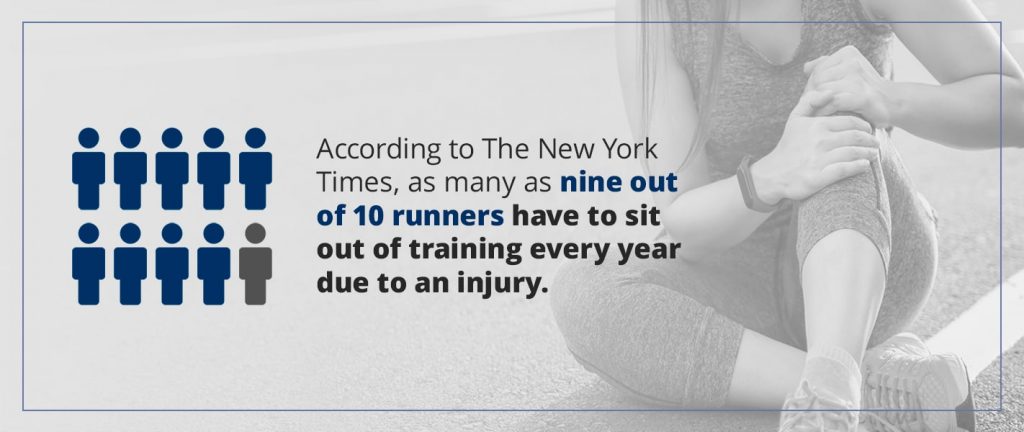
Running Injury Statistics
To understand the breadth of the problem, it’s helpful to consider some statistics. It’s difficult to pinpoint just how many runners experience injuries every year, but some experts estimate that it is up to 50%. Some statistics put that estimate considerably higher. As many as nine out of 10 runners have to sit out of training every year due to an injury, according to The New York Times.
A literature review from Sports Medicine found that different types of runners experienced injuries at considerably different rates. Ultra-marathon runners experience far more injuries that require medical attention than other types of runners. Novice runners experience the most time-loss injuries from running. Short-distance track runners also experience a high proportion of running injuries.
A 2018 study from The American Journal of Sports Medicine aimed to provide some insight into recreational runners’ injuries and their causes. Researchers observed a total of 300 runners over a period of two years. During that time, 199 of the runners — or 66% — sustained an injury. The percentage was higher for women at 73% and lower for men at 62%. It’s also interesting to note that more than half of the injured runners sustained more than one injury.
This study uncovered some potential risk factors that may lead to injuries during running. While several factors may contribute to injuries, the only significant predictor of injury was found to be knee stiffness — a problem that was more prevalent among runners with a higher body weight.
A 2019 study from the Journal of Sports Science & Medicine looked into the most common running injuries for men and women. The most frequently injured areas of the body were the same for both genders. These injuries were to the knee, ankle-foot and shank — the part of the leg between the knee and ankle. Knee injuries were more common for women than for men. For men, ankle-foot and shank injuries were more common.
The bottom line is that running injuries are common for both recreational and competitive runners and for both men and women. The most common injuries are overuse injuries involving the lower extremities of the body.
What Can You Do to Prevent Running Injuries?
They’re certainly commonplace, but can running injuries be avoided? Some injuries may, unfortunately, be unavoidable. For example, as we age, a lack of cartilage can leave our joints vulnerable to injury. Even a young, healthy runner may trip and suffer a sprain. However, runners can take some proactive steps to reduce their chance of injury. Let’s look at eight tips for how to avoid running injuries.
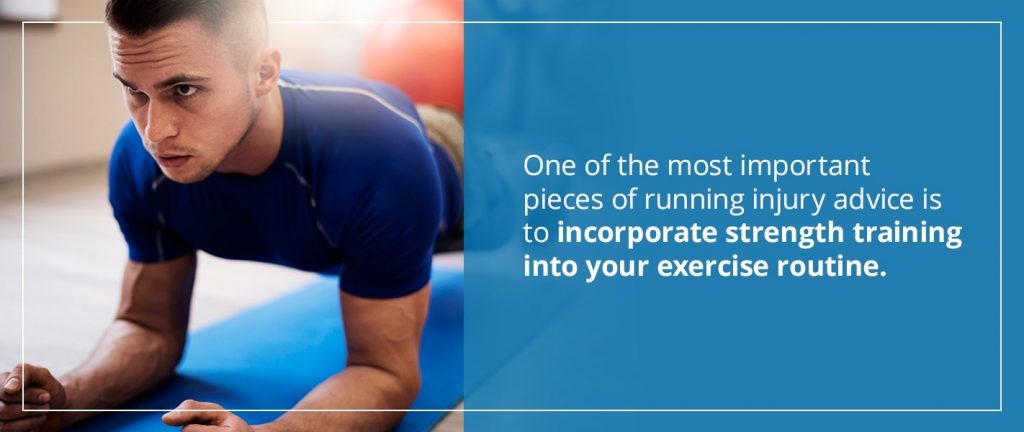
1. Strengthen Your Body
One of the most important pieces of running injury advice is to incorporate strength training into your exercise routine. This is because stronger muscles, tendons and ligaments will allow you to maintain a more stable, consistent form while running. Your muscles will contract as needed to steady your body parts and help you land solidly with each step. Weak muscles leave you unstable or force other muscles in your body to compensate, making those muscles more susceptible to RSIs.
If you already know a certain muscle group in your body is weaker than others, concentrate on strengthening this area. The major muscle groups include the chest, back, arms, abdominals, legs and shoulders. It’s also smart to focus on strengthening muscles surrounding joints. Some running injury prevention exercises you may want to work into your routine include lunges, step-ups, squats and planks. You can also do weight training exercises to strengthen your body.
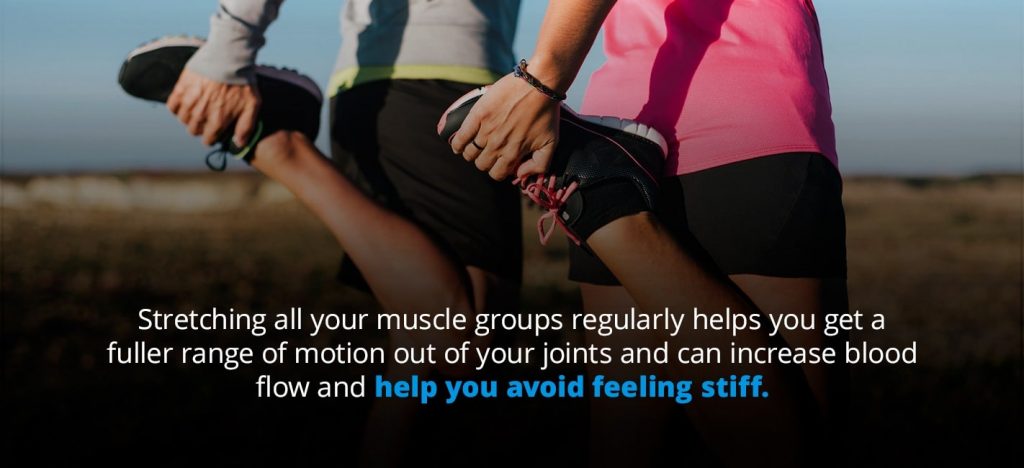
2. Stretch Regularly
Stretching should also be a part of your running injury prevention routine. Stretching all your muscle groups regularly helps you get a fuller range of motion out of your joints and can increase blood flow and help you avoid feeling stiff. All of these factors may work together to help you avoid muscle tears and other injuries.
Significant scientific evidence that stretching has a direct impact on reducing running injuries is currently lacking. Still, many runners will attest that stretching helps them run with better form and enjoy a more comfortable run. Stretching can also help runners avoid delayed-onset muscle soreness after running. That means stretching is a smart move if you’re interested in how to prevent pain while running.
Dynamic stretching is the best type of stretching to do just before a run. Dynamic stretching involves constant movements without holding certain positions for several seconds as you would with static stretching. Dynamic stretches, like torso twists or lunges, can warm up your body so you’re properly prepared for a run.
3. Only Push Yourself Gradually
Especially if you’re new to running, be careful about the way you push yourself. This is a general principle that applies to all types of physical activity. Trying to do too much too fast is a good recipe for injury. Even if you’ve been running for a long time, if you’ve had to take a break — especially if that break was due to an injury — make sure you ease back into running. Don’t assume you can jump back in at the same distance and intensity you were used to before your break.
The body needs time to adapt. Drastically increasing mileage or intensity can put too much demand on your body before it’s ready, resulting in a muscle tear or strain. You can certainly work toward a more intense running routine. Just make sure you work toward that goal one step at a time so you don’t push your body too hard.
When it comes to mileage, you can follow the 10% rule: Only increase your mileage by a maximum increment of 10% each time. For increasing intensity, try lowering your mileage when you try more intense running, such as running uphill. You can also use a heart rate monitor to gauge whether you need to begin a cool down and rest. It’s also critical that you listen to your body and rest your muscles when you feel pain.
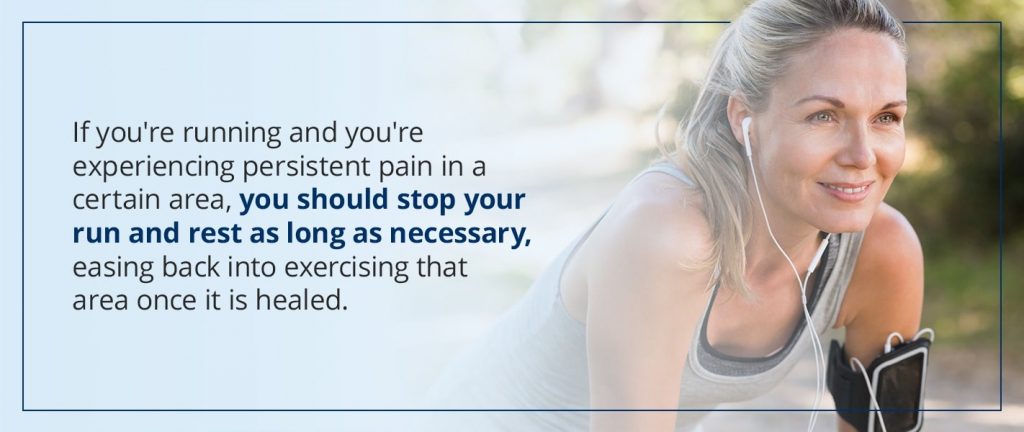
4. Rest When You Feel Pain
Consider the ways you can see an injury coming before it happens. One of the keys to injury prevention for runners is to listen to the pain signals that can indicate you’re at risk of an injury.
Pain is your body’s natural way of telling you it’s being pushed too far. Pain isn’t always sharp — It could feel like muscle cramps, aches or soreness. If you’re running and you’re experiencing persistent pain in a certain area, you should stop your run and rest as long as necessary, easing back into exercising that area once it is healed.
Consider recovery time an important part of your training routine rather than a disruption. If you push past pain, you could end up with a painful condition that keeps you on the couch for weeks or longer rather than allowing yourself to rest for just a day or two. Avoiding injury is always better than putting yourself at risk. Many conditions associated with running, such as muscle strains, can lead to more serious injuries, like tears, if you don’t nip them in the bud with proper treatment.
5. Practice Good Running Form
Proper form when you run doesn’t just make you look good — It helps you enjoy a more comfortable and safer running experience. Poor posture, for example, could put excess stress on areas like your back or knees. To maintain good posture, keep your upper body straight, centering your head above your shoulders as you run. Strengthening your core and upper body can help you maintain good posture more easily.
Another aspect of running form to pay attention to is your footfall. Landing heavily can put undue stress on your feet and ankles. Try making a conscious effort to land more softly. A shorter stride and landing on the midfoot can help lessen the impact during running. Lessening impact is a key part of how to prevent injury from running.

6. Run on Level Surfaces
Injuries like sprains and fractures can occur when you land the wrong way or suffer a fall. This scenario is more likely when you’re running on rough, uneven terrain. Experienced runners may enjoy running on these types of trails, but running on level surfaces is always the safest option. Therefore, if you’re a novice runner especially, stick to running on smooth surfaces.
This might include a running track, a paved pedestrian path or a sidewalk. Keep in mind that older sidewalks can crack and buckle from issues like tree roots. If you’re used to the sidewalks in your neighborhood and know they’re safe for running, that’s great. If you know there are potential tripping hazards, you may want to look for a different place to run. If you’re unfamiliar with a certain trail or path, consider scouting it out by walking the route before you attempt to run there.
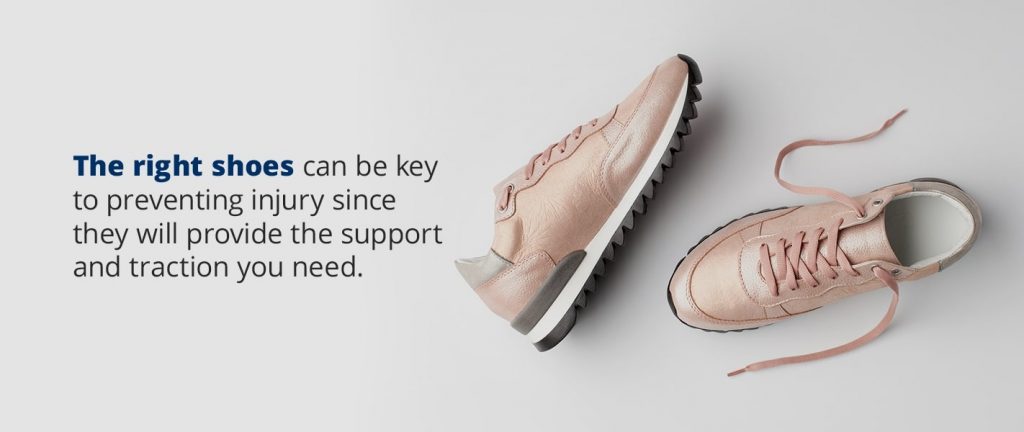
7. Choose the Right Shoes
Runners know just how important the right pair of shoes can be to helping them enjoy a comfortable run and avoid heel, arch or toe pain. Choosing the right shoes is more than an effective way to avoid pain while running. The right shoes can also be key to preventing injury since they will provide the support and traction you need.
The important thing to understand when it comes to running shoes is that there is no one perfect set of shoes for all runners. The right shoes for you will depend on your feet and your running habits. You may want to visit a store that specializes in running shoes and ask for help with sizing. The store clerk can factor in the length, width and arch of your feet along with your preferences and the type of terrain you like to run on to find the ideal shoes for you.
If you enjoy different types of terrain, then you may want to get a few pairs of shoes. For instance, you may have one pair that is grippy enough for trails, a flat pair for speedwork and a set of minimal shoes for drills. Even if you are pretty consistent with the type of running you do, cycling between a few pairs of shoes will change up how your feet and legs are impacted by force during a run, which may help you reduce repetitive stress in these areas. Replace shoes after every 400 to 600 miles.

8. Give Your Body the Fuel It Needs
Runners also understand that giving your body the right fuel before and after a run is an important part of a healthy running experience. Hydrating yourself and eating the right foods isn’t just about nutrition, though. Properly fueling your body can help you avoid injuries. Consider the alternative. When you aren’t properly hydrated and nourished, you’ll experience a dip in your performance.
Your brain may feel foggy, and you’ll feel more tired. This can lead to technical errors or overworking yourself in a way that invites injuries to occur. Make sure you fuel your body both before and after a run. When you’ve finished running, eat protein to help your muscles repair themselves. A savvy runner will take steps like this one after a run so they’re already preparing for their next run.
A nutritious, well-balanced diet can also help you maintain a healthy body weight. This is an effective way to ward off injuries since excess body weight puts more pressure on joints like your knees.

Quality Orthopedic Care From OrthoBethesda
If you’ve experienced a running injury, your thoughts may be on how to treat your current injury in addition to how running injuries can be prevented in the future. Even if you think you’ve healed from an injury, you may experience ongoing issues if the problem hasn’t been addressed fully.
Whether you need orthopedic surgery or physical, occupational or hand therapy, OrthoBethesda offers quality orthopedic treatment to help patients throughout the Washington metropolitan area. We start with a thorough evaluation so we understand the problem. Then we create a treatment plan and carry that treatment plan through to help your body recover and restore function. Schedule an appointment today to get started.
Related Content
- What Is a Sports Medicine Physician?
- Why College & High School Athletes Need Sports Medicine
- How to Prevent Concussions for Every High-Impact Sport
- How to Prevent Dance-Related Injuries
- Best Sports to Play If You’re Suffering From Osteoarthritis
- How to Prevent Soccer Injuries
- How to Prevent Sports Injuries
- Most Common Sports Injuries
- 4 Common Injuries Swimmers Should Be Aware Of
